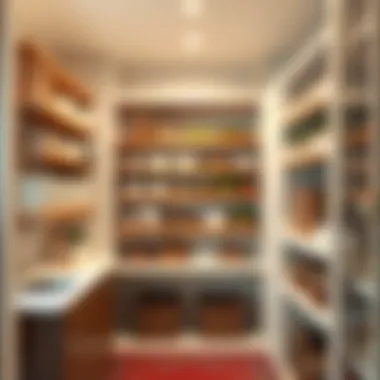Maximize Kitchen Space with Big Lots Pantry Solutions


Intro
When it comes to the heart of the home, the kitchen stands out, not just for its culinary creations but for its role as a central hub for family and friends. Among the many components that make a kitchen functional and inviting, the pantry often gets overlooked. It's more than just a closet for canned goods and spices; with the right approach, a pantry can become a veritable treasure trove of organization. Big Lots offers an expansive range of options to enhance pantry storage. Navigating the world of pantry solutions can feel overwhelming, but understanding the key components is crucial.
This article will explore the various aspects of kitchen pantry storage. From the latest furniture trends to practical tips on organizing and maintaining your pantry, we will dissect everything you need to know to create a space that is as functional as it is stylish. The conversation will touch on color palettes that can energize your pantry, optimizing space utilization, and how to maintain your chosen storage solutions effectively.
By the end of this piece, whether you are a seasoned homeowner or a DIY aficionado, you will understand how to maximize your pantry's potential with affordable and accessible options from Big Lots. Let's dive deep into the world of kitchen storage.
Understanding Kitchen Pantry Storage
In today's fast-paced world, the kitchen pantry plays a vital role in the overall functionality of a home. Understanding how to store and organize this space effectively can revolutionize your cooking experience. A well-organized pantry not only streamlines meal preparation but also enhances overall kitchen aesthetics and reduces waste—an aspect that is increasingly important, especially with the rising focus on sustainability. By understanding kitchen pantry storage, you can save time on grocery runs and find what you need at a moment's notice.
The Role of Kitchen Pantries
Kitchen pantries serve a multifaceted purpose. They act as more than mere storage spaces; they are the backbone of your culinary routines. By housing dry goods, canned items, snacks, and even small appliances, your pantry can significantly increase efficiency in the kitchen. A well-maintained pantry means that you can locate ingredients easily, minimize clutter, and create an inviting environment for both cooking and entertaining. Moreover, pantries make it simpler to maintain an organized shopping list and keep track of what you already have, preventing unnecessary purchases.
Storage Needs Assessment
A thorough assessment of your storage needs ensures your pantry works for you, not against you. Let’s break it down into three key components.
Evaluating Space
Evaluating space is the first step in understanding kitchen pantry storage. It involves taking a good look at the dimensions and layout of your pantry area. Perhaps you have a small closet or a full walk-in space. The most important characteristic of evaluating space is that it directly determines what storage solutions are feasible. For those with tight quarters, optimizing vertical space becomes essential. On the flip side, larger areas might call for a more varied layout. Proper evaluation ensures you have a beneficial foundation for everything that follows. This diligence minimizes wasted space and sets you up for success.
Identifying Essentials
Identifying essentials is another crucial piece of piecing together your perfect pantry. This refers to knowing what items you truly need on hand to simplify your daily routines. A common pitfall is keeping items just because they might be useful someday. The key characteristic here is prioritization. You need to figure out what’s absolutely necessary versus what’s just taking up space. This approach can be a beneficial choice because it creates clarity in your storage and allows you to make more thoughtful purchasing decisions going forward.
Decision on Style
When it comes to decision on style, there's no one-size-fits-all approach. Style decisions impact both functionality and aesthetics. The key characteristic of this decision is balancing form and function—what looks good should also work well. Choosing storage options that speak to your personal style, whether it's modern, rustic, or somewhere in between, can transform the pantry into an integral design element of your kitchen. However, such a decision can also come with its own unique challenges, like ensuring that trendy storage solutions still meet your practical needs.
Understanding kitchen pantry storage encompasses evaluating space, determining essentials, and making informed style decisions. This foundational knowledge sets the stage for utilizing the versatile storage options available at Big Lots, ensuring your pantry meets both your needs and design aspirations.
Exploring Big Lots Kitchen Storage Options
Exploring the storage options available at Big Lots is crucial for anyone seeking to craft a well-organized kitchen pantry. Each choice you make has the potential to streamline your cooking process and elevate your kitchen's overall efficiency. Big Lots stands out with a variety of affordable and stylish storage solutions that cater to diverse needs and tastes. This section shines a light on shelving units, storage bins, baskets, cabinets, and wardrobes, which together provide a solid foundation for building an efficient pantry space.
Shelving Units
Types of Shelving
Choosing the right type of shelving is fundamental to maximizing your pantry space. Big Lots offers an array of shelving options, from floating shelves to heavy-duty racks, allowing you to customize based on your specific needs. Floating shelves provide a modern look and can be adjusted for height, while ladder shelves offer a unique aesthetic and can act as simple decor as well as storage. The adaptability of these options speaks to their popularity—homeowners can curate their pantry's appearance and functionality all in one go. However, the choice of shelving type should also take into consideration the weight of your pantry items and your overall space layout.
Weight Capacity and Durability
When we talk about weight capacity and durability, it's not just about style; it’s about trust. You want your shelves to hold all those hefty jars of pickles or bags of flour without one wobble. Big Lots’ shelving units often boast impressive weight limits, some holding up to 200 pounds if properly installed. This strength ensures longevity, making it a reliable choice for the busy kitchen. Just keep in mind that heavier shelves often come with a heftier price tag and might require professional installation, depending on your home’s structure.
Placement Strategies
Placement strategies come into play when you're trying to achieve balance between accessibility and aesthetics. It’s a dance between what looks good and what works well. Are you handy with a screwdriver? Wall-mounted shelves are a fantastic option and allow for easy access to frequently used items. On the flip side, freestanding shelves can be repositioned, adapting to your kitchen's flow. The trick lies in strategically arranging your shelving to make your cooking as seamless as possible, ensuring frequently used items are within reach while also keeping lesser-used items tidy in the back.
Storage Bins and Baskets
Material Considerations
Material considerations are essential when selecting storage bins and baskets. Offered in a range of materials such as plastic, wire, and wicker, each comes with its strengths and weaknesses. Plastic bins are typically more affordable and easier to clean, making them a popular choice among busy families. Conversely, wire baskets lend a rustic charm to your pantry and allow for airflow, ideal for storing fruits and vegetables, albeit they may need occasional dusting.
Labeling Techniques
One of the smartest labeling techniques is arguably the key to an orderly pantry. With a well-thought-out labeling system, you can make sure everyone in the household knows where to put the snack bags or where the dried herbs reside. Chalkboard labels are a favorite because they’re reusable and can adapt as your pantry contents change. Alternatively, clear tape and a good printer can work wonders for a sleek, uniform look. The right labels will save time, and that time is gold when you are juggling dinner prep in the evenings.
Maximizing Vertical Space
Maximizing vertical space is often a game-changer in smaller kitchens. Tall shelving units and tiered organizers can elevate your storage game, ensuring every nook and cranny serves a purpose. By stacking bins or using modular designs, you make use of height that typically goes ignored. Big Lots often features organizers that enable creative layered storage, allowing you to store more within a compact area. It’s about leveraging all available space while keeping things neat and tidy, truly turning your pantry into a strategic masterpiece.
Cabinets and Wardrobes
Selecting the Right Size
Selecting the right size for cabinets and wardrobes is pivotal in ensuring your pantry looks organized rather than chaotic. The sizes available at Big Lots can accommodate various kitchen dimensions, from petite to grand. A well-sized cabinet can be a focal point while offering ample storage capabilities, thus avoiding overcrowding. An important tip here is to measure your space accurately before making any purchases—inaccurate measurements could result in cabinets that either don’t fit or end up taking over your entire kitchen.
Door Options


When looking at door options, it's essential to consider how you want to access space. Big Lots has cabinets with traditional swinging doors, sliding doors, or even open-faced designs. Each comes with its pros and cons; for instance, swinging doors may require more clearance while sliding doors can save space, particularly in tighter areas. The door option you choose reflects how quickly and easily you can access the items you need while cooking, so think about daily usage.
Integration with Existing Decor
Finally, integration with existing decor is not just a matter of personal taste, but also functionality. At Big Lots, you can find storage solutions that match your kitchen’s vibe, be it rustic, modern, or eclectic. A well-matched cabinet can harmoniously blend into your kitchen, enhancing its aesthetic appeal while remaining practical. Remember though, even the best integrations can look clumsy if the proportions or colors don’t align, so keep your eyes peeled for hues and styles that resonate with your overall kitchen design.
By delving into these aspects of kitchen storage available at Big Lots, one can effectively create a pantry space that is not only functional but also visually appealing. Whether you are streamlining operations in a small kitchen or optimizing storage to reflect personal style, Big Lots provides the tools necessary to make those visions a reality.
Designing Your Kitchen Pantry
When it comes to kitchen pantry storage, design plays a critical role in maximizing efficiency and functionality. A well-designed pantry not only enhances the visual appeal of your kitchen but also optimizes the space to meet your specific storage needs. By considering various elements such as layout, aesthetic appeal, and functionality, you can transform your pantry into a welcoming and practical area that works for you.
Layout Considerations
Open vs. Closed Storage
The decision between open and closed storage is significant in pantry design. Open storage allows for easy access to items, making it a popular choice among homeowners who seek convenience. This type of storage encourages organization since everything is visible, and it can prompt you to keep items in their designated places due to the lack of concealment.
On the flip side, closed storage offers a clean and sleek look. It keeps potentially unsightly items out of sight, giving your kitchen a more polished appearance. However, it can lead to forgotten items lurking in the back. Each approach has its advantages and disadvantages, but choosing the right option depends largely on your lifestyle and storage needs.
Utilizing Corners
Corners in kitchens are often underutilized, yet they can be a goldmine for storage solutions. Corner shelves or lazy Susans allow you to make the most of these tricky spaces. This method can help maximize your storage capacity while minimizing clutter.
The challenge with corners, however, is accessibility. Choosing the right storage solutions—like flexible shelving or pull-out drawers—can ensure that you’ll have easy access to all pantry items. Creativity with corner storage can dramatically improve the efficiency of your pantry layout.
Access and Flow
Access and flow are the backbone of effective pantry design. A well-thought-out layout ensures that frequently used items are easily reachable, minimizing the time spent rummaging around. It’s advisable to keep heavier items on lower shelves and lighter ones up high.
A good flow means that there’s never a cluttered or tight space when navigating through your pantry. This organization not only helps maintain order but also elevates the cooking experience by making everything accessible. Thoughtful placement of items can result in a kitchen that feels effortless to use.
Aesthetic Elements
Color Schemes
Color schemes can greatly influence the ambiance of your pantry. A cohesive color palette can make your pantry a visually pleasing extension of your kitchen. Whether you opt for bold colors to make a statement or soft hues for a calming effect, these choices can enhance the overall design.
Choosing a harmonious color scheme can also help to highlight certain areas of storage, guiding the eye and creating an organized feel. However, it’s crucial to consider the colors in the rest of your kitchen to ensure a smooth transition.
Materials and Textures
The right materials and textures can add depth and interest to your pantry. Wood, metal, and plastic all serve different purposes and convey various styles. For instance, reclaimed wood can add a rustic charm, while metal shelves give a modern edge.
Choosing durable materials is also important for longevity and maintaining a clean look. Each material has its unique features, and understanding their implications in terms of maintenance and aesthetics is essential for the overall design.
Styling Techniques
Styling your pantry doesn’t have to be an afterthought; it can be part of the design process. Utilizing uniform jars and labeled containers can take your pantry from plain to picture-perfect.
Consider using decor that resonates with your personal taste, such as wall art or decorative items that echo the kitchen's energy. However, keeping functionality at the forefront is crucial; too many decorative elements can clutter the space.
Personalization and Functionality
Reflecting Personal Taste
Personalizing your pantry can help create a space that reflects your style and needs. From choosing colors to arranging items in ways that speak to you, a personalized pantry can become a joy to use. It’s essential to infuse your personality into the design without compromising its functional purpose.
Finding a balance between personal aesthetics and practical storage is the key. Whether it’s through decorative bins or stylish labels, personalization can make your pantry not just a utility space but a representation of you.
Functional Accessories
Incorporating functional accessories increases the utility of your pantry. Items like drawer dividers, tiered shelves, or stackable bins can significantly enhance organization. These tools not only serve a functional purpose but also help maintain order over time.
Choosing accessories wisely—based on the size and style of your pantry—can create a customized approach that works seamlessly with your overall design. They add an element of practicality without sacrificing style.
Utilizing Technology
Embracing technology in pantry design is becoming increasingly popular. Smart gadgets like inventory management apps can track what you have, reducing food waste and streamlining grocery shopping.
While integrating technology, it's important to select tools that will genuinely enhance your experience, rather than complicate it. As tech options in kitchen storage continue to evolve, they promise to make organizing your pantry even easier.
Maintaining Your Pantry Space
Keeping a well-organized pantry is not just a matter of aesthetics; it plays a crucial role in ensuring that the kitchen operates smoothly. A tidy pantry helps eliminate frustration during food preparation, reduces waste, and prevents unwanted surprises when looking for that jar of spices or bag of flour. As such, understanding the best practices for maintaining your pantry can lead to a truly transformed cooking experience, turning it from chaotic to well-ordered.


Ultimately, maintaining your pantry involves several key elements: regular cleaning, tackling common issues like pests or moisture, and ensuring the items are easy to access. Embracing these aspects can be beneficial to any homeowner, DIYer, or designer looking to optimize their kitchen space.
Regular Cleaning and Organization
Establishing Routines
One of the most effective strategies for maintaining pantry efficiency is establishing routines. Regular cleaning schedules serve as a constant reminder to reorganize items, check for expired goods, and ensure everything is where it should be. Setting aside time weekly or monthly can keep clutter at bay and ensure the pantry is inviting.
What’s invaluable about such routines is their capacity to become automatic, making involvement in pantry upkeep feel less like a chore and more like an integral part of kitchen activities. This habit fosters engagement with the space, as you are more likely to remember when and why things belong where they do. However, the challenge lies in the initial commitment to establish these habits.
Identifying Expiration Dates
A vital aspect of pantry maintenance is identifying expiration dates on various food items. This goes beyond simply checking if something is still good to eat; it’s about being proactive in food management. Keeping an eye on expiry dates helps prevent waste and saves money, which supports a more sustainable lifestyle.
The practice of regularly checking these dates promotes mindfulness in meal planning and grocery shopping, ensuring the pantry contains only fresh ingredients. One unique feature of this approach is the potential to create a checklist or digital app that can send reminders when an item is nearing its expiration. However, it can become tedious if implemented poorly — you might find yourself overwhelmed with constantly checking every single product.
Prioritizing Accessibility
Another important factor is prioritizing accessibility. This involves arranging items in such a way that the most frequently used products are easy to grab, while those less often needed can be stored out of sight. Having an accessible pantry saves time during meal preparations, allowing anyone cooking to quickly find ingredients.
Using clear containers or labeled baskets helps maintain this level of accessibility. With this, it becomes intuitive to identify what’s available or if something needs to be replenished. The only downside is that it may require an overhaul of your existing organization strategy, but the results often make this effort worth it.
Addressing Common Issues
Pest Prevention
Pest prevention within a pantry is not just important — it is essential. Even the tidiest of spaces can become a dining room for pests like ants or pantry moths. Keeping food items stored in airtight containers is a good first step.
Utilizing natural deterrents such as bay leaves or peppermint not only helps in maintaining a pest-free pantry but can also add a pleasant scent. Interestingly, regular checks can often spot signs of infestation early, preventing further issues. The unique feature about pest prevention methods is their dual utility: they help maintain hygiene and can also contribute to an overall pleasant kitchen atmosphere.
Moisture Control
Moisture can wreak havoc in a pantry, leading to mold growth or spoiled food. Controlling humidity levels is crucial; therefore, investing in dehumidifiers or moisture absorbers can be a game changer. Additionally, ensuring proper ventilation in the kitchen area aids in maintaining a dry environment.
One unique advantage of addressing moisture control is that it can prolong the shelf life of food, leading to a significant reduction in waste. However, if moisture issues persist, it may be worthwhile to evaluate storage practices or even consider renovations to improve airflow.
Repurposing Items
Lastly, the concept of repurposing items can be highly effective in pantry maintenance. Rather than purchasing new storage solutions, think creatively about using what you already have. Glass jars from store-bought sauces can become excellent food containers, while old crates can serve as rustic shelves.
This approach fosters an environmentally friendly mindset by reducing waste while customizing space to fit your needs. The uniqueness lies in the ability to create something entirely new without spending extra money. However, balancing aesthetic charm with practical storage needs is vital to ensure functionality is not sacrificed.
In summary, maintaining your pantry space is about creating habits that promote organization, hygiene, and sustainability. Regular cleaning routines, awareness of expiration dates, prioritization of accessibility, pest prevention, moisture control, and rethinking the use of existing items can transform even the most cluttered pantry into a well-functioning and enjoyable area.
Adapting to Different Kitchen Layouts
Understanding how to adapt pantry storage solutions to different kitchen layouts is central to achieving a well-organized and efficient space. Each kitchen environment presents unique challenges and opportunities. Recognizing these factors helps you make informed choices, ensuring that storage solutions not only accommodate items but also enhance the overall functionality and aesthetic of the space. This is particularly vital for homeowners, designers, and DIY enthusiasts seeking to optimize their kitchens in a manner that reflects both personal tastes and practical needs.
Small Kitchens
Space-Saving Solutions
When it comes to small kitchens, clever space-saving solutions can transform the overall functionality of the pantry. One notable strategy is utilizing vertical storage. This involves installing shelves that reach up to the ceiling; effectively using every inch available. Wall-mounted racks can hold spices or frequently used cooking tools, freeing up counter space for meal prep.
The key characteristic of these solutions lies in their ability to maximize limited area. They allow homeowners to store all essentials without feeling cramped. One unique feature is the use of pull-out drawers in cabinets, enabling easy access to items that would otherwise be difficult to reach. However, one disadvantage might be the upfront effort in organizing the space afresh, which could be daunting.
Smart Storage Strategies
Implementing smart storage strategies in a smaller kitchen focuses on multi-use items and modular designs. By choosing storage bins that can nestle neatly into one another or purchasing modular shelving that can be reconfigured as needs change, you create a flexible system that grows with your family. This adaptability can accommodate everything from canned goods to small kitchen appliances.
The primary appeal of smart storage solutions is their versatility; they cater to changing needs without requiring a complete overhaul of the pantry setup. However, integrating too many modular elements can sometimes lead to clutter if not managed properly. Regular reassessment of your storage needs is essential.
Multi-Function Furniture
Multi-function furniture is another hallmark of handling space constraints effectively. For instance, a dining table that doubles as a prep surface not only saves room but enhances efficiency during cooking and dining. This approach aligns well with the shifting dynamics of households, where significant gatherings are common.
The most compelling feature of multi-function furniture is its adaptability—furniture can serve more than one purpose without taking up additional space. A drawback, however, might be the potential compromise on style. Multi-function items can often lean towards being more utilitarian than aesthetic, which may not appeal to everyone.
Large Kitchens
Zoning Areas
In larger kitchens, it’s crucial to create zoning areas to enhance ease of use. This involves categorizing space based on function—such as cooking zones, prep areas, and storage zones. For example, a separate baking corner equipped with flour, sugar, and baking tools allows for streamlined processes.


The foundational principle of zoning areas is organization. By coupling tools and ingredients together, cooking becomes more enjoyable and efficient. Yet, it can sometimes feel scattered if zones aren’t well defined. Regular planning and layout adjustments can mitigate such issues.
Maximizing Storage Units
Maximizing the use of storage units in a spacious kitchen allows more room to breathe while keeping everything orderly. Custom cabinets that fit the kitchen’s footprint provide ample space for various items—think about pull-out pantries that house canned goods or a designated area for mixing bowls. This maximization makes it feasible to have everything at an fingertips distance.
Storage units can employ specialized designs, such as corner cabinets with unique rotating shelves, which can utilize even the trickiest of spaces. Nevertheless, going for an overly complex system can lead to a hefty price tag and potential confusion about which spaces house which items.
Emphasizing Style
Finally, emphasizing style in a larger kitchen presents an opportunity to blend aesthetics with functionality. With more space, differing materials and colors can be strategically placed to enhance the kitchen's overall atmosphere. For example, combining rustic wooden shelves with sleek modern cabinets can create a unique vibe.
The highlight of emphasizing style is the potential for personal touch. Each homeowner can express their personality through their cabinetry and pantry design. On the downside, focusing too heavily on looks might affect practicality, so it's critical to strike a balance where style does not overshadow usability.
Open Concept Designs
Streamlined Aesthetic
In open concept designs, a streamlined aesthetic plays a crucial role in marrying the kitchen with adjoining living spaces. Utilizing consistent materials and colors throughout creates an unbroken visual flow. This can be accomplished through integrated cabinetry that smooths transitions between kitchen and living areas, effectively enhancing aesthetic appeal while maintaining a cohesive look.
The central advantage of this design is its ability to make the kitchen feel more spacious, giving it an inviting atmosphere ideal for hosting. Yet, achieving such harmony may require more planning and forethought than traditional designs, as one misstep in aesthetic choice can disrupt the flow.
Functional Divisions
Functional divisions in open concept kitchens aim at segregating areas without erecting barriers. For instance, using a large kitchen island defines the cooking zone while serving as a gathering spot simultaneously. This functionality allows for easy movement between areas, which is ideal during social gatherings.
The essence of functional division lies in flexibility and function. Creating distinct areas enhances usability that caters to every need of the household. However, one pitfall might be that too many divisions can cause some aspects to feel isolated rather than inviting.
Connection to Living Spaces
Establishing a connection to living spaces provides a seamless transition between your kitchen and other areas of your home. Open shelving that overlooks the living room allows for display, potentially turning everyday items into decorative pieces as well. Furthermore, having a layout that allows for interaction with family and friends while cooking enhances the overall experience of being in the kitchen.
The defining characteristic here is connectivity. A well-connected space fosters inclusion in culinary activities. Still, distractions could arise, and it may become difficult to manage kitchen tasks while participating in gatherings. Having a plan in place to manage this can ease potential frustrations.
Ultimately, adapting pantry storage solutions to fit different kitchen layouts is about finding what works best. Whether it be space-saving ideas in small kitchens or the style and functionality of larger spaces, being mindful of specific needs and layouts can produce rewarding results.
Budget-Friendly Options at Big Lots
When it comes to kitchen pantry storage, managing costs effectively is crucial. Big Lots offers numerous budget-friendly options that allow homeowners to elevate their pantry setups without breaking the bank. Finding cost-effective solutions can make a substantial difference in how efficiently you organize your kitchen, ultimately translating into a more functional and enjoyable space. By concentrating on practical solutions, consumers can transform their pantries with minimal financial strain.
Cost Comparison
Pricing Analysis
Pricing analysis is essential for identifying where to spend your dollars wisely. Big Lots stands out with its competitive prices on kitchen storage solutions. Think about it—when you know what similar products cost at other stores, you're able to spot the deals at Big Lots. For instance, if you compare their shelving units to a high-end retailer, you may find that you’re saving a good chunk of change while still enjoying quality products. Their pricing strategy is structured to attract budget-conscious shoppers, ensuring that even those with tight budgets can find suitable storage.
One highlight of the pricing analysis is the transparency that Big Lots provides. Their clear pricing structure means you won’t end up facing surprise fees, which is a common issue in some retailers today. This reliability makes it a favored choice for many individuals looking to enhance their kitchen organization without high expenditures.
Quality vs. Price
Quality versus price isn’t just a buzzword; it's a vital consideration for homeowners at Big Lots. The key here is understanding that just because a product is affordable doesn’t mean it’s low quality. Often, shoppers find that pantry storage items at Big Lots strike an impressive balance between quality and price. Customers frequently rave about the durability of their cabinets and bins.
This option has advantages like longevity, which means you're investing in your pantry's furniture rather than merely renting it for a few months. Admittedly, not all products will match up to premium brands, but for the intended use in pantries, they generally hold up well. It’s a practical choice for those who want efficiency in their kitchen without sacrificing the quality of materials.
Seasonal Discounts
One of the most exciting aspects of shopping at Big Lots is the seasonal discounts they offer. It’s always worth keeping an eye on the sales calendar! These discounts can provide fantastic opportunities to grab needed pantry items at even lower prices. Customers can score significant savings, especially during major sales events, where they may find items at prices that make you double-take.
The unique feature of seasonal discounts is that they often apply to a wide selection of products, from large shelving units to smaller organizational bins. This flexibility allows you to outfit your pantry fully, letting creativity flow while staying budget-conscious. However, it's worth noting that popular items can quickly sell out during these promotions, so timing is key.
DIY Alternatives
When it comes to budgeting, consider unearthing those DIY skills. Creating stylish and functional storage solutions at home can save you money while offering personalization that you won't find in standard store-bought products.
Repurposing Household Items
Repurposing household items is a clever way to avoid extra spending altogether. It involves using items you already own and giving them a fresh purpose in the pantry. For example, old jars can serve as perfect storage for spices; a wooden crate can become a charming fruit basket. This practice not only reduces waste but also gives character to your pantry.
The beauty in repurposing is its cost-effectiveness. You’re essentially breathing new life into items that would otherwise gather dust. However, it does require some creativity and patience, and while it may not yield the polished look that brand-new items can provide, the uniqueness can add warmth to your space.
Sourcing Local Materials
There’s something inherently satisfying about sourcing local materials for DIY pantry projects. Whether it's reclaimed wood for shelves or natural fiber baskets from a local artisan, these options can support your community while injecting your pantry with character. This aspect contributes significantly to both your budget and your project’s integrity.
Prioritizing local can also minimize costs if you can find goods that don’t include hefty shipping fees. While it might not always be the easiest route, reaching out to local businesses can turn up some hidden gems. Just be sure to factor in the time and effort that often comes with sourcing locally.
Creative Upcycling Ideas
Tap into creative upcycling ideas for your kitchen storage needs. This can take the form of transforming an old ladder into a tiered shelf or turning a vintage suitcase into a chic storage container. Not only does this save money, but it also adds a unique charm that mass-produced items often lack.
One important advantage of upcycling is the ability to fully customize the look and functionality of your pantry. You can choose colors and styles that resonate with your personal taste. The downside? It takes time and a willingness to experiment with various materials to find what works best. But the payoff—a stunning pantry that speaks to your creativity—is worth the effort.















